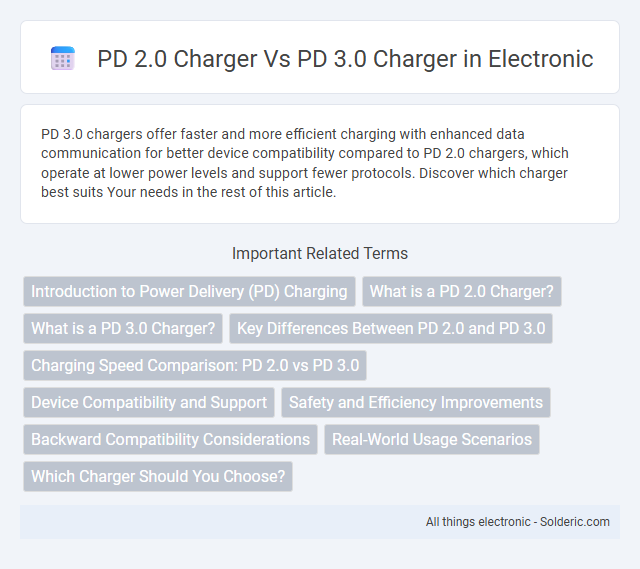PD 3.0 chargers offer faster and more efficient charging with enhanced data communication for better device compatibility compared to PD 2.0 chargers, which operate at lower power levels and support fewer protocols. Discover which charger best suits Your needs in the rest of this article.
Comparison Table
| Feature | PD 2.0 Charger | PD 3.0 Charger |
|---|---|---|
| Power Delivery Standard | USB Power Delivery 2.0 | USB Power Delivery 3.0 |
| Maximum Power Output | Up to 100W | Up to 100W |
| Efficiency | Standard efficiency | Improved efficiency with optimized power negotiation |
| Power Negotiation | Basic negotiation for voltage and current | Enhanced negotiation with Programmable Power Supply (PPS) |
| Programmable Power Supply (PPS) | Not supported | Supported, enables dynamic voltage and current adjustment |
| Compatibility | Compatible with PD 2.0 devices | Backward compatible with PD 2.0 and supports PD 3.0 devices |
| Security Features | Basic security | Improved communication security and error handling |
| Use Case | Standard fast charging | Optimized fast charging and safer power delivery |
Introduction to Power Delivery (PD) Charging
Power Delivery (PD) 2.0 and PD 3.0 chargers both support fast charging by delivering variable voltage and current to optimize power transfer to compatible devices. PD 3.0 improves upon version 2.0 by offering enhanced power negotiation, more precise current control, and increased efficiency, enabling faster and safer charging for smartphones, laptops, and tablets. Key features of PD 3.0 include Programmable Power Supply (PPS) support and extended voltage ranges, which are not available in PD 2.0 chargers.
What is a PD 2.0 Charger?
A PD 2.0 charger supports the Power Delivery 2.0 protocol, which allows for flexible power negotiation up to 100W, enabling faster charging for compatible devices compared to standard USB chargers. This technology dynamically adjusts voltage and current levels based on your device's requirements, optimizing charging efficiency and safety. While it lacks some advanced features found in PD 3.0, PD 2.0 chargers remain highly effective for powering laptops, smartphones, and tablets.
What is a PD 3.0 Charger?
A PD 3.0 charger is an advanced USB Power Delivery (PD) standard that supports faster and more efficient charging by dynamically adjusting voltage and current up to 100W, enabling compatibility with a wider range of devices from smartphones to laptops. It features programmable power supply (PPS) technology for fine-tuned power delivery, reducing heat generation and improving battery health. Compared to PD 2.0 chargers, PD 3.0 offers enhanced negotiation protocols, allowing more precise and flexible power management.
Key Differences Between PD 2.0 and PD 3.0
PD 3.0 chargers offer enhanced power delivery with improved efficiency, support for higher wattages up to 100W, and dynamic power adjustments compared to PD 2.0 chargers, which have fixed voltage levels and lower maximum power outputs. The advanced communication protocols in PD 3.0 enable faster charging speeds and better compatibility with a wider range of devices. When choosing your charger, PD 3.0 ensures optimal performance and quicker charging for modern smartphones, laptops, and other USB-C devices.
Charging Speed Comparison: PD 2.0 vs PD 3.0
PD 3.0 chargers offer significantly faster charging speeds compared to PD 2.0, supporting up to 100W power delivery with dynamic voltage and current adjustments for optimal efficiency. PD 2.0 chargers typically max out at 60W and lack the advanced power negotiation features found in PD 3.0. Enhanced communication protocols in PD 3.0 enable quicker device recognition and power allocation, resulting in reduced charging times across compatible devices.
Device Compatibility and Support
PD 3.0 chargers offer enhanced device compatibility by supporting a wider range of voltage and current profiles, ensuring faster and more efficient charging for the latest smartphones, tablets, and laptops. In contrast, PD 2.0 chargers provide basic power delivery but may not fully optimize charging speeds for newer devices with advanced power requirements. Your choice of charger affects how effectively your device can leverage power delivery standards for optimal performance and battery health.
Safety and Efficiency Improvements
PD 3.0 chargers incorporate advanced safety protocols such as programmable power supply (PPS), reducing the risk of overheating and enhancing device protection compared to PD 2.0 models. Efficiency improvements include dynamic voltage adjustments that optimize power delivery, minimizing energy loss and charging time. These enhancements result in safer, faster, and more reliable charging performance across a wide range of compatible devices.
Backward Compatibility Considerations
PD 3.0 chargers offer enhanced power delivery protocols while maintaining backward compatibility with PD 2.0 devices, ensuring your existing gadgets can safely charge without performance loss. However, PD 3.0 chargers incorporate improved communication standards that allow faster and more efficient power negotiation compared to PD 2.0 chargers. Choosing a PD 3.0 charger guarantees seamless support for older devices while optimizing charging speed for newer compatible hardware.
Real-World Usage Scenarios
PD 3.0 chargers deliver faster and more efficient power delivery compared to PD 2.0, especially noticeable in high-demand devices like laptops and gaming consoles. Real-world scenarios such as charging a MacBook Pro or Samsung Galaxy S series benefit from PD 3.0's intelligent power negotiation, reducing charge times significantly. While PD 2.0 suits basic smartphone and tablet charging, PD 3.0 excels in multi-device setups requiring dynamic power management and faster energy transfer.
Which Charger Should You Choose?
Choose a PD 3.0 charger for faster charging speeds, improved power efficiency, and broader device compatibility compared to PD 2.0. PD 3.0 supports higher wattages, up to 100W, allowing quicker charging for laptops, smartphones, and tablets. For users needing future-proofing and optimal device performance, PD 3.0 is the recommended choice over PD 2.0 chargers.
PD 2.0 charger vs PD 3.0 charger Infographic

 solderic.com
solderic.com